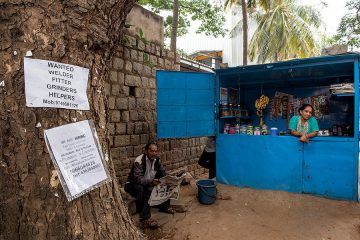Howard LaFranchi in The Christian Science Monitor:
 The sleek blue-glass building of the Infosys corporation sits like an intruding spaceship amid the unpaved side streets and half-completed residential structures that surround it. Its giant porthole windows offer a peek into a Jetsons-esque world of workers gliding between floors on elevated moving sidewalks. For now, 19-year-old Nishank Nachappaa toils in the shadows of Infosys and the other high-tech companies that, like him, call the Electronic City section of Bangalore home. The high school graduate helps out at two dormitories for tech workers – one for young men, the other for young women – that his parents manage. His father maintains the buildings and his mother prepares meals for the 120 male and 30 female residents. Walk a block or two from the dorms and other corporate structures loom with multinational names such as Emerson and Yokogawa, Altametrics and Hewlett Packard.
The sleek blue-glass building of the Infosys corporation sits like an intruding spaceship amid the unpaved side streets and half-completed residential structures that surround it. Its giant porthole windows offer a peek into a Jetsons-esque world of workers gliding between floors on elevated moving sidewalks. For now, 19-year-old Nishank Nachappaa toils in the shadows of Infosys and the other high-tech companies that, like him, call the Electronic City section of Bangalore home. The high school graduate helps out at two dormitories for tech workers – one for young men, the other for young women – that his parents manage. His father maintains the buildings and his mother prepares meals for the 120 male and 30 female residents. Walk a block or two from the dorms and other corporate structures loom with multinational names such as Emerson and Yokogawa, Altametrics and Hewlett Packard.
…The country has addressed much of the abject destitution that vast numbers of Indians lived in 25 years ago. As a result, it appears ready to join not just China but also South Korea, Indonesia, Vietnam, and other Asian neighbors that have either made the leap to middle-income prosperity or are well on their way. Along with its world-class space program, assertive foreign policy, and global cultural presence, India is trying to leverage its economic clout and privileged relationship with the United States into a more prominent role among world powers.
And yet, the country that will soon be the planet’s most populous – India is on track to surpass China in 2027– and is perhaps the world’s most culturally and linguistically diverse, also faces a number of key challenges that could yet stifle its rise. Among them: a huge, underproductive rural population and economically inactive female population; a heavy state footprint in the economy that discourages private enterprise and foreign investment; rising political divides and religious tensions; and a lingering post-independence mindset of reliance on the state. It’s a daunting list – one that echoes the period, more than a decade ago, when a first wave of “India’s time has come” declarations coursed through the country.
More here.
